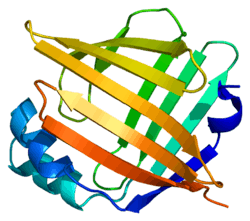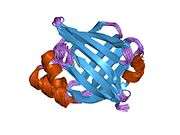FABP5
Fatty acid-binding protein, epidermal is a protein that in humans is encoded by the FABP5 gene.[3][4]
This gene encodes the fatty acid binding protein found in epidermal cells, and was first identified as being upregulated in psoriasis tissue. Fatty acid binding proteins are a family of small, highly conserved, cytoplasmic proteins that bind long-chain fatty acids and other hydrophobic ligands. It is thought that FABPs roles include fatty acid uptake, transport, and metabolism.[4]
Interactions
FABP5 has been shown to interact with S100A7.[5][6]
References
Further reading
- Rasmussen HH, van Damme J, Puype M, et al. (1993). "Microsequences of 145 proteins recorded in the two-dimensional gel protein database of normal human epidermal keratinocytes". Electrophoresis. 13 (12): 960–9. doi:10.1002/elps.11501301199. PMID 1286667.
- Siegenthaler G, Hotz R, Chatellard-Gruaz D, et al. (1994). "Purification and characterization of the human epidermal fatty acid-binding protein: localization during epidermal cell differentiation in vivo and in vitro". Biochem. J. 302 (2): 363–71. PMC 1137237
 . PMID 8092987.
. PMID 8092987.
- Maruyama K, Sugano S (1994). "Oligo-capping: a simple method to replace the cap structure of eukaryotic mRNAs with oligoribonucleotides". Gene. 138 (1–2): 171–4. doi:10.1016/0378-1119(94)90802-8. PMID 8125298.
- Siegenthaler G, Hotz R, Chatellard-Gruaz D, et al. (1993). "Characterization and expression of a novel human fatty acid-binding protein: the epidermal type (E-FABP)". Biochem. Biophys. Res. Commun. 190 (2): 482–7. doi:10.1006/bbrc.1993.1073. PMID 8427590.
- Masouyé I, Saurat JH, Siegenthaler G (1996). "Epidermal fatty-acid-binding protein in psoriasis, basal and squamous cell carcinomas: an immunohistological study". Dermatology (Basel). 192 (3): 208–13. doi:10.1159/000246367. PMID 8726632.
- Jaworski C, Wistow G (1997). "LP2, a differentiation-associated lipid-binding protein expressed in bovine lens". Biochem. J. 320 (1): 49–54. PMC 1217896
 . PMID 8947466.
. PMID 8947466.
- Masouyé I, Hagens G, Van Kuppevelt TH, et al. (1997). "Endothelial cells of the human microvasculature express epidermal fatty acid-binding protein". Circ. Res. 81 (3): 297–303. doi:10.1161/01.res.81.3.297. PMID 9285630.
- Suzuki Y, Yoshitomo-Nakagawa K, Maruyama K, et al. (1997). "Construction and characterization of a full length-enriched and a 5'-end-enriched cDNA library". Gene. 200 (1–2): 149–56. doi:10.1016/S0378-1119(97)00411-3. PMID 9373149.
- Watanabe R, Fujii H, Yamamoto A, et al. (1998). "Immunohistochemical distribution of cutaneous fatty acid-binding protein in human skin". J. Dermatol. Sci. 16 (1): 17–22. doi:10.1016/S0923-1811(97)00615-4. PMID 9438903.
- Hagens G, Masouyé I, Augsburger E, et al. (1999). "Calcium-binding protein S100A7 and epidermal-type fatty acid-binding protein are associated in the cytosol of human keratinocytes". Biochem. J. 339 (2): 419–27. doi:10.1042/0264-6021:3390419. PMC 1220173
 . PMID 10191275.
. PMID 10191275.
- Hagens G, Roulin K, Hotz R, et al. (1999). "Probable interaction between S100A7 and E-FABP in the cytosol of human keratinocytes from psoriatic scales". Mol. Cell. Biochem. 192 (1–2): 123–8. doi:10.1023/A:1006894909694. PMID 10331666.
- Hohoff C, Börchers T, Rüstow B, et al. (1999). "Expression, purification, and crystal structure determination of recombinant human epidermal-type fatty acid binding protein". Biochemistry. 38 (38): 12229–39. doi:10.1021/bi990305u. PMID 10493790.
- O'Shaughnessy RF, Seery JP, Celis JE, et al. (2001). "PA-FABP, a novel marker of human epidermal transit amplifying cells revealed by 2D protein gel electrophoresis and cDNA array hybridisation". FEBS Lett. 486 (2): 149–54. doi:10.1016/S0014-5793(00)02252-3. PMID 11113456.
- Gutiérrez-González LH, Ludwig C, Hohoff C, et al. (2002). "Solution structure and backbone dynamics of human epidermal-type fatty acid-binding protein (E-FABP)". Biochem. J. 364 (Pt 3): 725–37. doi:10.1042/BJ20020039. PMC 1222622
 . PMID 12049637.
. PMID 12049637.
- Strausberg RL, Feingold EA, Grouse LH, et al. (2003). "Generation and initial analysis of more than 15,000 full-length human and mouse cDNA sequences". Proc. Natl. Acad. Sci. U.S.A. 99 (26): 16899–903. doi:10.1073/pnas.242603899. PMC 139241
 . PMID 12477932.
. PMID 12477932.
- Gevaert K, Goethals M, Martens L, et al. (2004). "Exploring proteomes and analyzing protein processing by mass spectrometric identification of sorted N-terminal peptides". Nat. Biotechnol. 21 (5): 566–9. doi:10.1038/nbt810. PMID 12665801.
- Ruse M, Broome AM, Eckert RL (2003). "S100A7 (psoriasin) interacts with epidermal fatty acid binding protein and localizes in focal adhesion-like structures in cultured keratinocytes". J. Invest. Dermatol. 121 (1): 132–41. doi:10.1046/j.1523-1747.2003.12309.x. PMID 12839573.
- Ha MK, Chung KY, Lee JH, et al. (2005). "Expression of psoriasis-associated fatty acid-binding protein in senescent human dermal microvascular endothelial cells". Exp. Dermatol. 13 (9): 543–50. doi:10.1111/j.0906-6705.2004.00196.x. PMID 15335354.
- Gerhard DS, Wagner L, Feingold EA, et al. (2004). "The status, quality, and expansion of the NIH full-length cDNA project: the Mammalian Gene Collection (MGC)". Genome Res. 14 (10B): 2121–7. doi:10.1101/gr.2596504. PMC 528928
 . PMID 15489334.
. PMID 15489334.
PDB gallery |
|---|
|
| 1b56: HUMAN RECOMBINANT EPIDERMAL FATTY ACID BINDING PROTEIN |
| 1jjj: SOLUTION STRUCTURE OF RECOMBINANT HUMAN EPIDERMAL-TYPE FATTY ACID BINDING PROTEIN |
|
|

 . PMID 8092987.
. PMID 8092987. . PMID 8947466.
. PMID 8947466. . PMID 10191275.
. PMID 10191275. . PMID 12049637.
. PMID 12049637. . PMID 12477932.
. PMID 12477932. . PMID 15489334.
. PMID 15489334.
